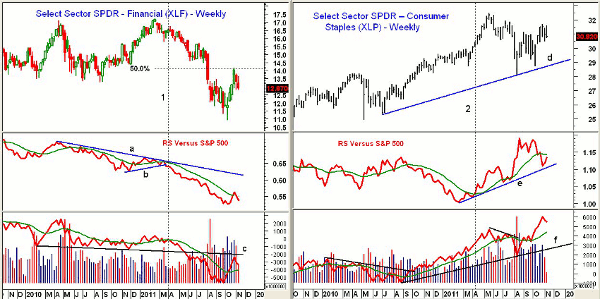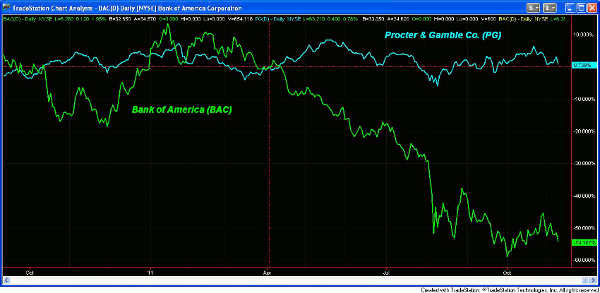Maintain only light exposure to lower-priced but higher-risk sectors like financials, instead counting on relative performance, or RS analysis, to stay in the strongest areas of the market.
Early selling in Europe set the tone for what was a very ugly day in the US markets on Wednesday. The small- and mid-cap stocks were hit the hardest, with the mid-cap S&P 400 down 4.3% and the small-cap Russell 2000 down 4.8%.
Though all 30 stocks in the Dow Industrials were down 1% or more, there were some bright spots. The specialty eateries industry group, which includes stocks like Starbucks (SBUX), Panera Bread (PNRA), and Caribou Coffee (CBOU), was up 5.8% for the day.
On the downside, the Regional Mid-Atlantic Banks industry group, which includes Bank of America (BAC), BB&T Corporation (BBT), and BankUnited, Inc. (BKU), was down 4.7%. Some of the broader measures of the financial sector did even worse, with the NYSE Financial Index down 5.7%.
This further reinforces the need for not only diversification, but more importantly, sector selection. The best method I have found for selecting sectors and industry groups is the relative performance, or RS analysis. So given Wednesday’s slide, which sectors are the strongest and which should be avoided?
Chart Analysis: When looking at the RS analysis, it is the weekly outlook that is the most important. The Select Sector SPDR - Financial (XLF) has had rough year, as it closed 2010 at $15.95 and settled yesterday at $12.87. This is a decline of 19.3%, but it was much worse just a month ago when XLF hit a low of $10.95.
- The rally from the October lows took XLF just slightly above the 50% Fibonacci retracement resistance at $14.10
- There is stronger resistance in the $15-$15.50 area
- The weekly RS line started forming lower highs and lower lows in 2010. It is currently well below the long-term downtrend, line a
- The RS tested its declining weighted moving average (WMA) last March and then broke support (line b) in early April, line 1. It would now need to move above its prior peak to stabilize the outlook
- The weekly on-balance volume (OBV) also fell below its WMA in April before dropping sharply. The OBV is now above its weighted moving average but did not form any positive divergences at the September lows
- The daily OBV (not shown) is still slightly positive
The Select Sector SPDR - Consumer Staples (XLP) is always considered one of the more defensive sector ETFs. It ended 2010 at $29.31 and closed yesterday at $30.82, up just over 5%.
- There is initial support in the $30 area with the weekly uptrend, line d, now at $29.70. There is more important support at $28.07 and the August lows
- The weekly RS analysis turned higher in March and moved sharply above its WMA in April (line 2)
- The RS line turned up from its uptrend, line e, in October. A drop below the October lows would be a sign of weakness
- The weekly OBV is acting stronger than prices and has surged to new all-time highs
- The volume was heavy in August and then broke the short-term downtrend in September. There is good OBV support at line f
NEXT: Two Popular Stocks with Very Different Stories
|pagebreak|Procter & Gamble (PG) is one of the better-known consumer staples stocks and is frequently recommended. In August, PG reached its yearly low of $57.56 and is currently trading about 9% above those lows. First good support stands at $60.30.
Bank of America (BAC) has been in the news frequently this year, but rarely from a positive perspective. I have commented regularly on the stock since my analysis turned negative in March (see “Big Banks Flunk Smell Test”).
The percentage chart of these two stocks clearly illustrates how their performance has diverged since April.
Since the start of April, PG is up 0.74%, which is still better than the 7.1% decline in the Spyder Trust (SPY). In contrast, BAC is down over 54% during the same period.
What It Means: For the majority of a stock portfolio, investors should concentrate on stocks for which the weekly RS analysis is positive.
The intermediate-term analysis for the financial stocks is still negative, and it will take some time before it could turn positive. In the financial sector, the regional banks and asset managers do act better and may bottom first. Still, light positions are recommended in these financial industry groups.
See related: Regional Banks Ready to Break Out
The outlook for the Select Sector SPDR - Consumer Staples (XLP) is still positive based on the weekly RS analysis. If stocks rally more sharply into the end of the year, however, the defensive sectors may fall out of favor.
How to Profit: On Thursday morning, the selling in Asia was heavy as those markets try to catch up with Europe and the US. European stocks were a bit higher and US futures were also positive a few hours before the New York opening.
Stocks will need to rally impressively to reverse the negative short-term momentum from Wednesday’s drop. The Advance/Decline (A/D) numbers were very negative on Wednesday. A quiet, but higher close on Thursday may set the stage for more selling Friday unless the Eurozone begins to get its act together.























